Advertising LED displays are reshaping both outdoor and indoor advertising strategies by delivering dynamic, flexible, and highly visible campaigns. Traditional billboards, however, remain iconic for cost-effective, long-term static exposure. Choosing between the two requires a deep understanding of technology, costs, engagement, procurement, and future trends. This article provides a comprehensive analysis of advertising LED displays versus traditional billboards in 2025, supported by market studies, technical parameters, and procurement insights.
Advertising LED displays are digital signage systems built with light-emitting diodes, capable of projecting vibrant images, animations, and videos at high brightness. They serve as versatile communication tools across retail, entertainment, transportation, and corporate spaces.
Key elements of an advertising LED display include:
LED screen modules: The building blocks that determine resolution and pixel pitch.
Control systems: Software and hardware that manage content scheduling, brightness, and synchronization.
Power systems: Ensuring stable operation under different environmental conditions.
Protective housing: Weatherproofing for outdoor LED screens and lightweight enclosures for indoor LED screens.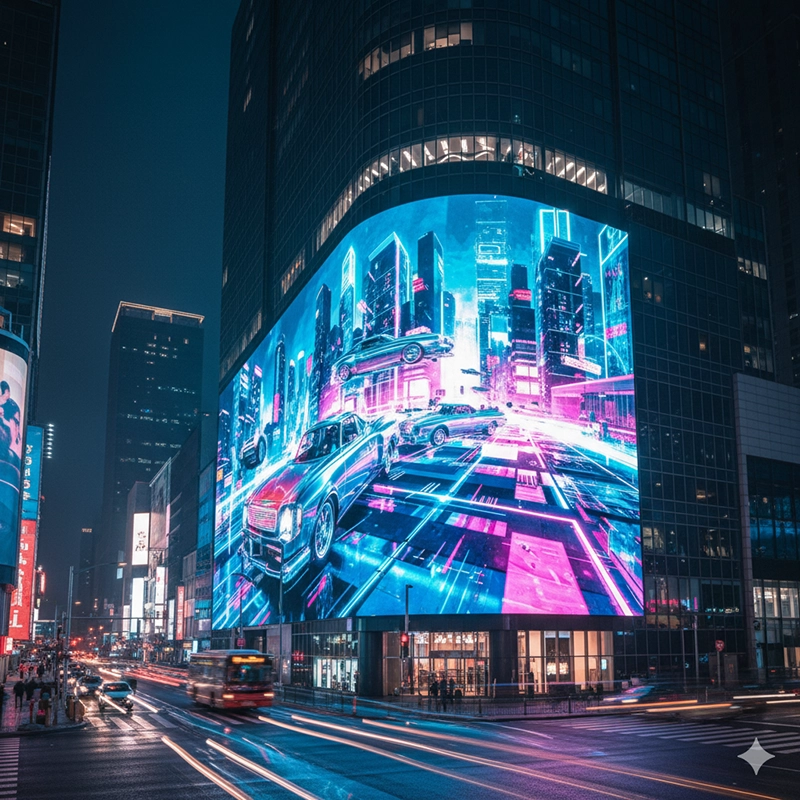
LED billboards are large-scale installations that replace traditional posters with digital visuals. They are commonly found on highways, rooftops, and busy intersections. Unlike static billboards, LED billboards can display multiple campaigns simultaneously, maximizing advertiser value.
An LED video wall combines multiple panels into one massive display. Commonly installed in stadiums, airports, and corporate headquarters, they provide immersive experiences and can serve dual roles for branding and live communication.
Indoor LED screens are optimized for fine pixel pitch, ensuring crisp visibility at close distances. They are essential for exhibitions, retail shops, and conference centers where clarity and design integration matter.
Advertising LED displays cover diverse formats—from LED billboards to transparent LED displays—making them highly adaptable across industries.
Traditional billboards rely on printed vinyl, posters, or painted visuals. They are static and remain unchanged until physically replaced.
Poster boards and painted signs represent the oldest forms of advertising media. They are affordable but unsuitable for campaigns requiring frequent updates.
Outdoor LED screens offer vibrant, dynamic content in urban centers and along major roads. Their ability to adjust brightness automatically ensures round-the-clock visibility.
While traditional billboards focus on simplicity and cost, advertising LED displays expand the advertiser’s toolkit with digital flexibility.
Advertising LED displays outperform static billboards in audience attention due to brightness and motion.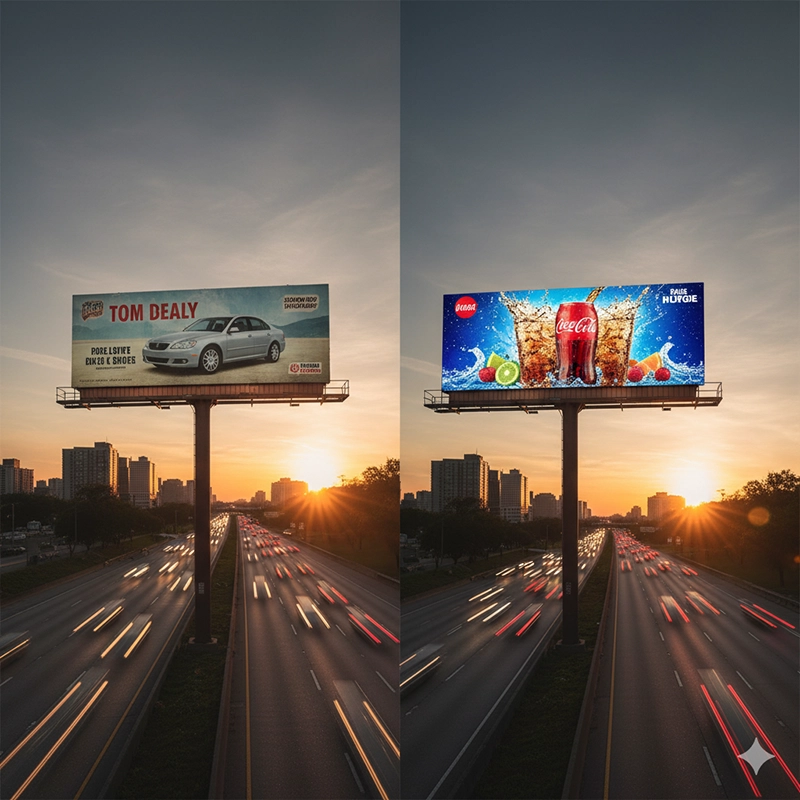
Creative LED screens use curved or 3D shapes to attract viewers. For example, a cylindrical LED display in a shopping mall creates a unique storytelling medium that cannot be replicated by static signs.
Transparent LED displays allow integration with glass facades. They provide dual functionality—advertising space without blocking natural light or architectural transparency.
Rental LED screens are widely used in concerts, exhibitions, and outdoor festivals. Their portability allows advertisers to reuse equipment in multiple campaigns, reducing cost over time.
Dynamic visuals from advertising LED displays consistently outperform static boards, particularly in environments where competition for attention is high.
Advertising LED displays require investment in panels, control systems, and installation. Costs vary by size, pixel pitch, and brightness.
Traditional billboards need only printing and mounting, making them significantly cheaper at the outset.
Advertising LED displays provide greater ROI for campaigns that require frequent updates or multiple advertisers sharing the same screen. LED display manufacturers offering OEM/ODM customization ensure clients maximize returns through tailored solutions.
LED displays consume electricity and require technical servicing.
Traditional billboards have minimal maintenance needs but incur recurring costs with each content change.
| Factor | Advertising LED Display | Traditional Billboards |
|---|---|---|
| Initial Investment | High (panels, installation, software) | Low (printing and mounting) |
| Maintenance | Moderate (electricity, repairs) | Low (occasional replacement) |
| Content Update Speed | Instant, remote | Manual, labor-intensive |
| ROI Potential | High, supports multiple advertisers | Stable, suitable for static ads |
Advertising LED displays cost more upfront, but their long-term ROI and flexibility often outweigh traditional billboard savings.
To further understand the technology, the following table highlights key performance differences.
| Parameter | Advertising LED Display | Traditional Billboards |
|---|---|---|
| Brightness (Nits) | 5,000 – 10,000 (adjustable) | Depends on external lighting |
| Lifespan | 80,000 – 100,000 hours | Material durability only |
| Pixel Pitch | P1.2 – P10 (indoor/outdoor) | Not applicable |
| Content Flexibility | Video, animation, interactive features | Static images only |
| Update Frequency | Instant, remote | Weeks (manual replacement) |
From a technical standpoint, advertising LED displays dominate in brightness, lifespan, and flexibility—critical advantages for modern advertisers.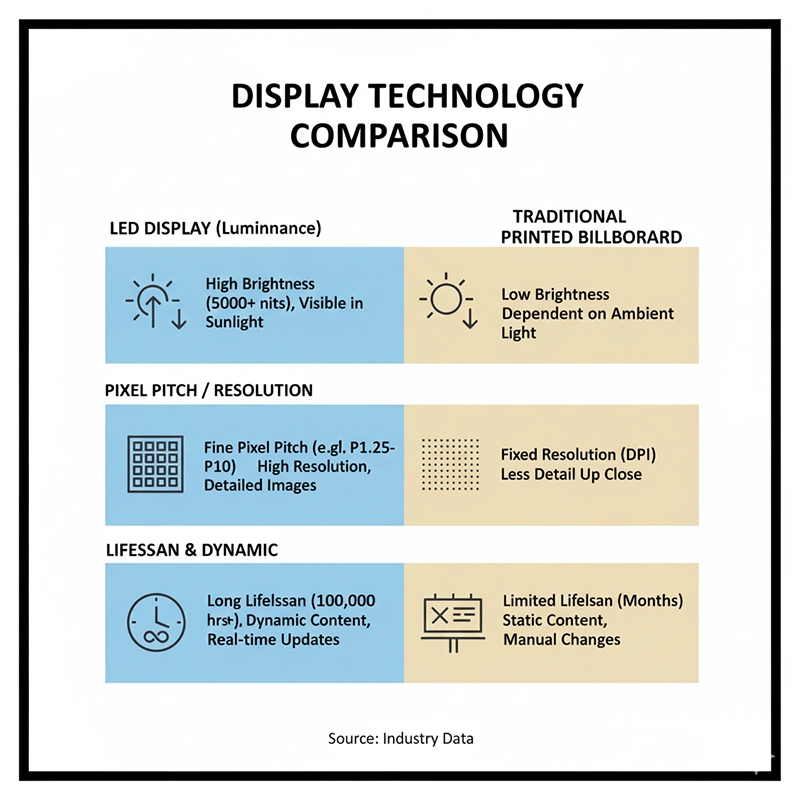
Bright, dynamic, and engaging visuals.
Content can be updated instantly and remotely.
Multiple advertisers can share one screen.
Supports interactivity through QR codes and live integration.
Enhances brand recall compared to static imagery.
Higher upfront investment than billboards.
Dependence on electricity and digital systems.
Subject to technical malfunctions.
Regulatory restrictions on brightness in urban areas.
While advertising LED displays demand higher costs, their advantages in visibility and adaptability make them a superior long-term investment.
Affordable for small businesses.
Durable against weather conditions.
Familiar and widely accepted by regulators.
Strong presence in highways and rural areas.
Content updates are costly and slow.
Lack of interactivity and dynamism.
Limited visibility without external lighting.
Generates environmental waste from repeated prints.
Traditional billboards remain relevant for cost-sensitive markets but lack the technological advantages of LED displays.
A multinational brand implemented indoor LED screens across 100 stores, achieving 18% sales growth due to dynamic in-store promotions.
Outdoor LED screens in sports arenas displayed live scores, sponsorship ads, and fan interactions. Static billboards failed to provide similar engagement.
Transparent LED displays in airports displayed dynamic content without obstructing natural light. Passenger surveys indicated 25% higher recall compared to static posters.
Traditional billboards on rural highways still provided long-term brand exposure for automotive campaigns, demonstrating value despite lack of interactivity.
Case studies confirm that advertising LED displays deliver higher engagement, though static billboards remain effective in specific long-term brand campaigns.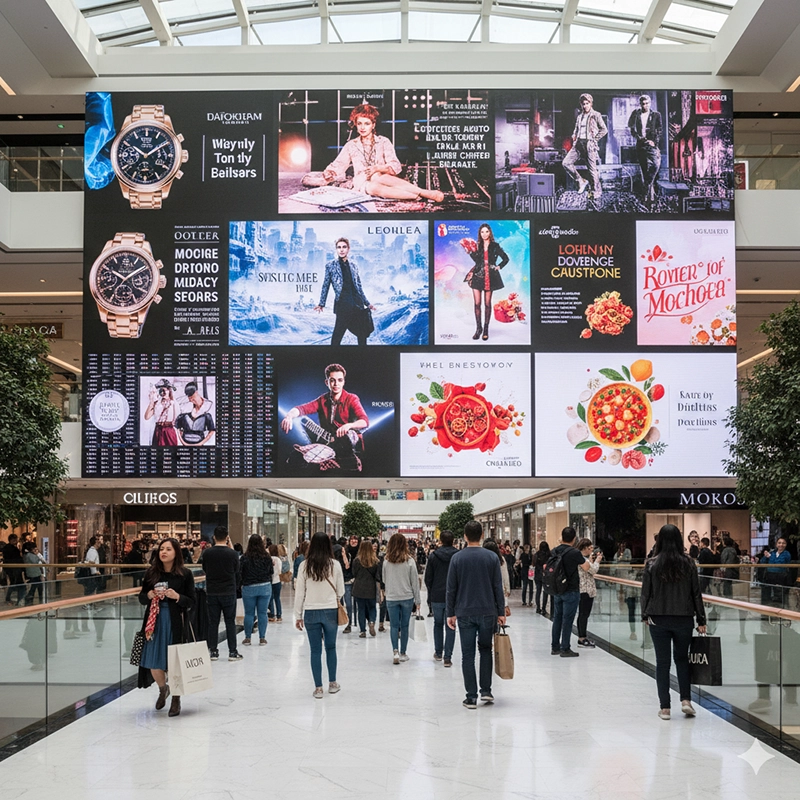
LED display manufacturers provide customization for outdoor LED screens, creative LED screens, and transparent LED screens. Procurement teams benefit from factory-direct sourcing for better pricing and tailored solutions.
Indoor LED screens are common in exhibitions and corporate spaces. Their fine pixel pitch ensures high-quality visuals in close-range viewing.
Rental LED screens dominate temporary campaigns for exhibitions, concerts, and political events, offering unmatched flexibility.
The wide range of advertising LED display solutions—from OEM customization to rental use—ensures adaptability across industries and campaigns.
Advertising LED displays outperform static billboards by enabling interactive features and motion graphics.
QR-enabled LED screens in retail settings reported 25% higher customer engagement rates.
LED displays can cycle through multiple ads, whereas billboards remain locked to one campaign until replaced.
Creative LED screens often connect with real-time social campaigns, bridging digital and physical advertising.
Audience engagement strongly favors advertising LED displays, particularly when campaigns leverage digital interactivity.
Pixel pitch and resolution.
Brightness and power efficiency.
Warranty and after-sales service.
Experience in OEM/ODM customization.
Indoor LED screens for malls, exhibitions, and conferences.
Outdoor LED screens for highways and urban centers.
Transparent LED displays for glass buildings and showrooms.
Creative LED screens for immersive brand experiences.
Rental LED screens for temporary campaigns.
Requires printing, logistics, and space rental agreements. While simpler, it lacks the adaptability of digital signage.
Procurement decisions should balance budget constraints with long-term ROI, often tipping the scale toward advertising LED displays.
MicroLED technology improving resolution.
AI-driven content optimization for targeted audiences.
Energy-efficient LEDs reducing operational costs.
Integration with smart city infrastructure.
Traditional billboards will remain in cost-sensitive and rural markets but with declining global market share. Hybrid approaches (static billboards with QR code add-ons) may extend relevance.
According to LEDinside (2024), the global outdoor LED display market is expected to grow at 14% CAGR, driven by demand in retail and sports venues. Meanwhile, OAAA (Outdoor Advertising Association of America) reports that digital out-of-home advertising revenue already accounts for 30% of total billboard revenue in North America, a share expected to increase annually.
Industry data strongly suggests that advertising LED displays are on track to dominate the future of outdoor advertising, with traditional billboards maintaining niche relevance.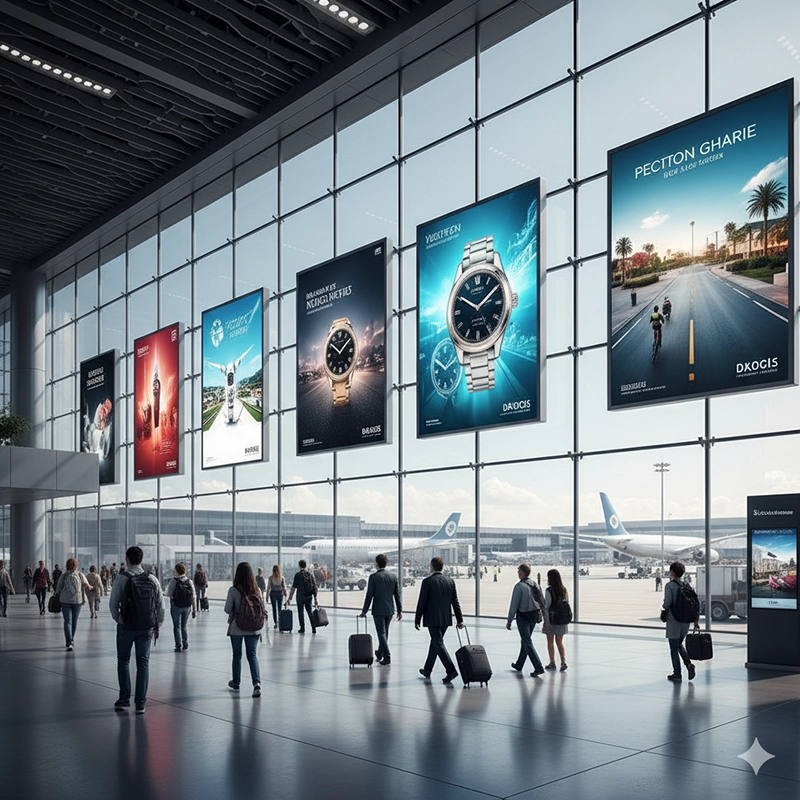
Advertising LED displays provide superior flexibility, engagement, and ROI, making them the preferred choice for modern businesses in 2025. Traditional billboards remain useful for static, long-term campaigns but lack adaptability.
For small businesses with limited budgets: Traditional billboards remain cost-effective for simple, long-term brand visibility.
For medium to large enterprises: Advertising LED displays deliver higher engagement and measurable ROI through dynamic, interactive campaigns.
For event-based marketing: Rental LED screens provide flexibility and scalability unmatched by billboards.
Final Insight: Both advertising LED displays and traditional billboards will coexist in 2025, but the growth trajectory, backed by LEDinside and OAAA data, favors LED solutions as the dominant force in global advertising.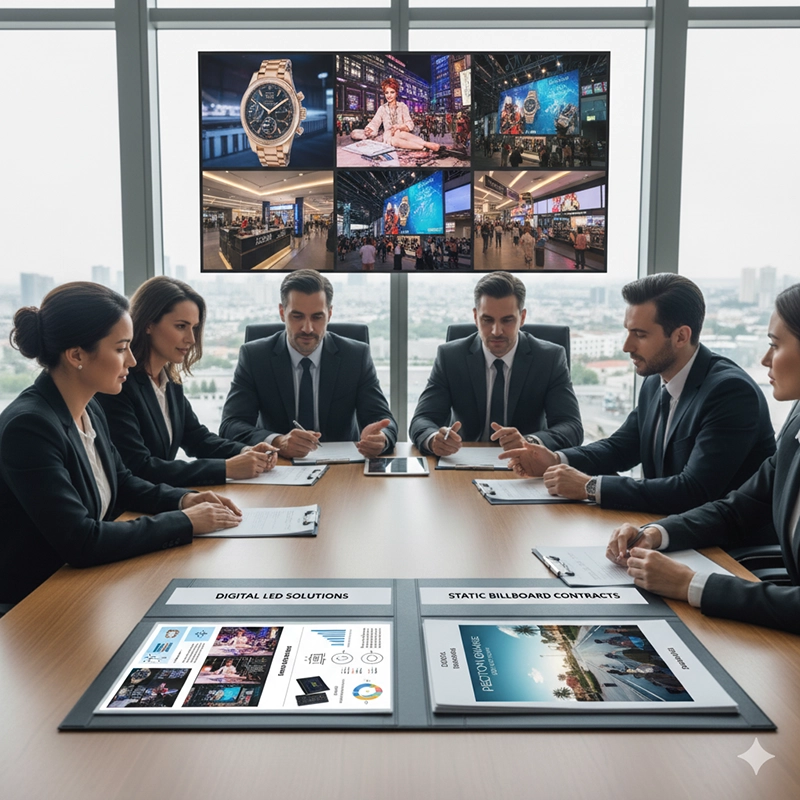
Hot Recommendations
Hot Products
Get a Free Quote Instantly!
Talk to Our Sales Team Now.
If you are interested in our products, please contact us promptly
Reach out to our sales team to explore customized solutions that perfectly meet your business needs and address any questions you may have.
Email Address:info@reissopto.comFactory Address:Building 6, Huike Flat Panel Display Industrial Park, No. 1, Gongye 2nd Road, Shiyan Shilong Community, Bao'an District, Shenzhen city , China
whatsapp:+8615217757270